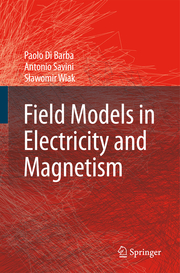Detailansicht
Field Models in Electricity and Magnetism
ISBN/EAN: 9781402068423
Umbreit-Nr.: 1147255
Sprache:
Englisch
Umfang: x, 174 S.
Format in cm:
Einband:
gebundenes Buch
Erschienen am 27.02.2008
Auflage: 1/2008
- Zusatztext
- Inhaltsangabe1 Introduction. 2 Vector fields. 2.1 Basic operators and equations. 2.2 Electrostatic field. 2.3 Magnetostatic field. 2.4 Steady conduction field. 3 Analytical methods for solving boundary-value problems. 3.1 Method of Green's functions. 3.2 Method of images. 3.3 Method of separation of variables. 4 Numerical methods for solving boundary-value problems. 4.1 Variational formulation in magnetostatics. 4.2 Finite elements for two-dimensional magnetostatics. 4.3 Finite elements for three-dimensional magnetostatics. 5 Timevarying electromagnetic field. 5.1 Maxwell's equations in differential form. 5.2 Poynting's vector. 5.3 Maxwell's equations in frequency domain. 5.4 Plane waves in an infinite domain. 5.5 Wave and diffusion equations in terms of vectors E and H. 5.6 Wave and diffusion equations in terms of scalar and vector potentials. 5.7 Electromagnetic field radiated by an oscillating dipole. 5.8 Diffusion equations in terms of dual potentials. 5.9 Weak eddy current in a conducting plane under a.c. conditions. 5.10 Strong eddy current in a conducting plane under a.c. conditions. 5.11 Eddy current in a cylindrical conductor under step excitation current. 5.12 Electromagnetic field equations in different reference frames. 6 Inverse problems. 6.1 Direct and inverse problems. 6.2 Well-posed and ill-posed problems. 6.3 Fredholm's integral equation of the first kind. 6.4 Case study: synthesis of magnetic field sources. 6.5 Under- and over-determined systems of equations. 6.6 Least-squares solution. 6.7 Classification of inverse problems. 7 Optimization. 7.1 Solution of inverse problems by the minimization of a functional. 7.2 Constrained optimization. 7.3 Multiobjective optimization. 7.4 Gradient-free and gradient-based methods. 7.5 Deterministic vs non-deterministic search. 7.6 A deterministic algorithm of lowest order: simplex method. 7.7 A non-deterministic algorithm of lowest order: evolution strategy. 7.8 Numerical case studies. 8 Conclusion. References. Acknowledgements. APPENDIX.
- Kurztext
- Covering the development of field computation in the past forty years, Field Models in Electricity and Magnetism intends to be a concise, comprehensive and up-to-date introduction to field models in electricity and magnetism, ranging from basic theory to numerical applications. The approach assumed throughout the whole book is to solve field problems directly from partial differential equations in terms of vector quantities. Theoretical issues are illustrated by practical examples. In particular, a single example is solved by different methods so that, by comparison of results, limitations and advantages of the various methods are made clear. The subjects of the synthesis of fields and of the optimal design of devices, which are growing in research and so far have not been adequately covered in textbooks, are developed in addition to more classical subjects of analysis. Topics covered include: vector fields: electrostatics, magnetostatics, steady conduction; analytical methods for solving boundaryvalue problems; numerical methods for solving boundaryvalue problems; timevarying electromagnetic field; inverse problems; optimization. Field Models in Electricity and Magnetism results from the cooperation of three authors in teaching electromagnetic theory at various levels and in different countries.
- Autorenportrait
- Inhaltsangabe1 Introduction. 2 Vector fields. 2.1 Basic operators and equations. 2.2 Electrostatic field. 2.3 Magnetostatic field. 2.4 Steady conduction field. 3 Analytical methods for solving boundary-value problems. 3.1 Method of Green's functions. 3.2 Method of images. 3.3 Method of separation of variables. 4 Numerical methods for solving boundary-value problems. 4.1 Variational formulation in magnetostatics. 4.2 Finite elements for two-dimensional magnetostatics. 4.3 Finite elements for three-dimensional magnetostatics. 5 Timevarying electromagnetic field. 5.1 Maxwell's equations in differential form. 5.2 Poynting's vector. 5.3 Maxwell's equations in frequency domain. 5.4 Plane waves in an infinite domain. 5.5 Wave and diffusion equations in terms of vectors E and H. 5.6 Wave and diffusion equations in terms of scalar and vector potentials. 5.7 Electromagnetic field radiated by an oscillating dipole. 5.8 Diffusion equations in terms of dual potentials. 5.9 Weak eddy current in a conducting plane under a.c. conditions. 5.10 Strong eddy current in a conducting plane under a.c. conditions. 5.11 Eddy current in a cylindrical conductor under step excitation current. 5.12 Electromagnetic field equations in different reference frames. 6 Inverse problems. 6.1 Direct and inverse problems. 6.2 Well-posed and ill-posed problems. 6.3 Fredholm's integral equation of the first kind. 6.4 Case study: synthesis of magnetic field sources. 6.5 Under- and over-determined systems of equations. 6.6 Least-squares solution. 6.7 Classification of inverse problems. 7 Optimization. 7.1 Solution of inverse problems by the minimization of a functional. 7.2 Constrained optimization. 7.3 Multiobjective optimization. 7.4 Gradient-free and gradient-based methods. 7.5 Deterministic vs non-deterministic search. 7.6 A deterministic algorithm of lowest order: simplex method. 7.7 A non-deterministic algorithm of lowest order: evolution strategy. 7.8 Numerical case studies. 8 Conclusion. References. Acknowledgements. APPENDIX.
